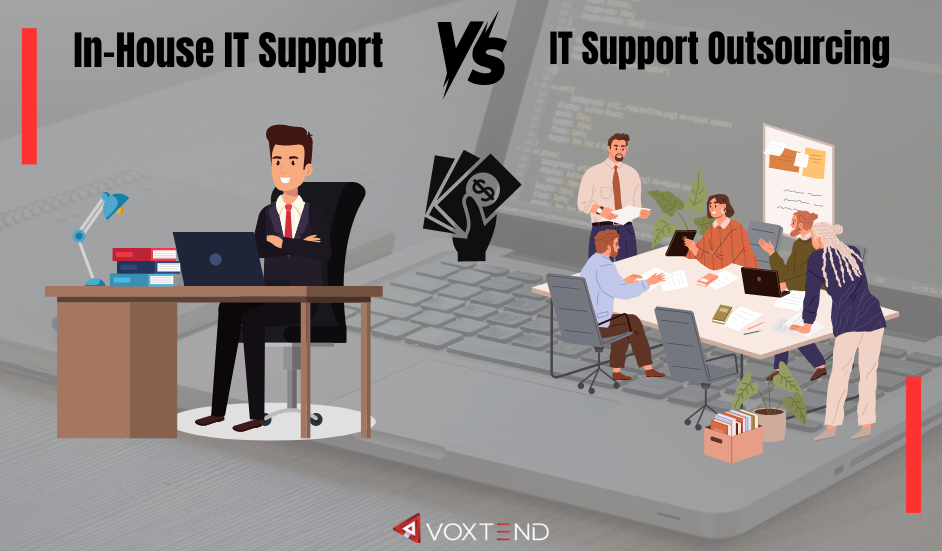An organization’s IT infrastructure is its foundation. Whether managing day-to-day operations or driving innovation, reliable IT support is crucial. However, a significant dilemma often arises when businesses decide between maintaining an in-house IT team or outsourcing their IT needs. While both options have their merits, they also come with hidden costs that can impact a company’s bottom line. This blog will explore the intricacies of in-house IT support versus outsourcing, shedding light on the often-overlooked expenses associated with each approach.
In-House IT Support
In-house IT support has been the traditional choice for many businesses, offering proximity, control, and a deep understanding of company systems. However, this approach also comes with its share of challenges and hidden costs that can impact the bottom line.
- Proximity and Accessibility
One of the most significant advantages of in-house IT support is its proximity and accessibility. Having an IT team on-site means immediate assistance whenever technical issues arise. Whether it’s troubleshooting software glitches, setting up new hardware, or addressing network problems, having IT professionals readily available can minimize downtime and keep operations running smoothly. Employees can simply walk down the hall or pick up the phone to get the help they need, leading to faster problem resolution and increased productivity.
- Familiarity with Company Systems
Another benefit of in-house IT support is its familiarity with company systems. Internal IT staff are intimately acquainted with the organization’s infrastructure, applications, and workflows. They understand the unique requirements and challenges of the business, allowing them to tailor solutions that align with company goals and objectives. This level of familiarity fosters a sense of ownership and commitment among IT personnel, leading to proactive maintenance and continuous improvement of IT systems.
- Control and Customization
In-house IT support also provides greater control and customization over technology solutions. Businesses have the flexibility to design and implement systems according to their specific needs and preferences. Whether it’s developing custom software applications, configuring network settings, or implementing security protocols, in-house IT teams have the autonomy to make decisions that best suit the organization. This level of control can be invaluable in ensuring that IT solutions are aligned with business objectives and regulatory requirements.
- Burden of Recruitment and Training
Despite its advantages, maintaining an in-house IT team comes with its own set of challenges. One of the most significant is the burden of recruitment and training. Finding skilled IT professionals who possess the right combination of technical expertise and interpersonal skills can be a daunting task. Moreover, the technology landscape is constantly evolving, requiring ongoing training and development to stay abreast of the latest trends and best practices. Investing in recruitment and training programs can be costly and time-consuming, diverting resources away from other areas of the business.
- Overhead Costs and Infrastructure Maintenance
In addition to recruitment and training expenses, in-house IT support also incurs overhead costs and infrastructure maintenance. Salaries, benefits, and office space for IT personnel contribute to the overall operational expenses of the business. Moreover, maintaining and upgrading IT infrastructure, including servers, networking equipment, and software licenses, requires a significant financial investment. Regular maintenance tasks such as software updates, security patches, and hardware repairs can also consume valuable time and resources.
Outsourced IT Support
Outsourcing IT support has become increasingly popular among businesses looking to leverage specialized skills, reduce costs, and improve scalability. While outsourcing offers several advantages, it also comes with its own set of challenges and considerations that must be carefully weighed.
- Access to Specialized Skills and Expertise
One of the primary advantages of outsourcing IT support is gaining access to specialized skills and expertise. External IT service providers often employ a team of professionals with diverse backgrounds and technical competencies. Whether it’s cybersecurity, cloud computing, data analytics, or software development, businesses can tap into a wealth of knowledge and experience that may not be available in-house. This access to specialized skills allows businesses to tackle complex IT challenges more effectively and stay competitive in a rapidly evolving digital landscape.
- Cost Efficiency and Predictability
Outsourcing IT support can also lead to cost efficiency and predictability. Service contracts with external providers typically offer fixed monthly or annual fees, allowing businesses to budget more accurately and avoid unexpected expenses. Moreover, outsourcing eliminates the need for upfront investments in infrastructure, software licenses, and personnel, reducing capital expenditure and freeing up financial resources for other strategic initiatives. By leveraging economies of scale and sharing resources across multiple clients, external providers can offer cost-effective solutions without compromising on quality or service levels.
- Flexibility and Scalability
Another advantage of outsourcing IT support is the flexibility and scalability it provides. External providers can quickly adapt to changing business needs and scale their services up or down as required. Whether adding new users, expanding into new markets, or integrating emerging technologies, businesses can rely on external providers to provide the necessary support and expertise. This flexibility allows businesses to respond more effectively to market dynamics and seize new opportunities without being constrained by internal resources or capabilities.
- Dependency on External Providers
However, outsourcing IT support also comes with its own challenges, chief among them being dependency on external providers. Relying on third-party vendors for critical IT functions can introduce risks related to service disruptions, data breaches, and vendor lock-in. Businesses must carefully evaluate the reliability and reputation of potential providers and establish clear service level agreements (SLAs) to ensure accountability and performance standards are met. Moreover, businesses must have contingency plans in place to mitigate the impact of any disruptions or failures in outsourced IT services.
- Communication and Response Time
Communication and response time are also important considerations when outsourcing IT support. Unlike in-house teams that are physically present within the organization, external providers may be located in different time zones or operate on different schedules. This can lead to delays in communication and response times, particularly in urgent or time-sensitive situations. Businesses must establish clear channels of communication and escalation procedures to ensure issues are addressed promptly and effectively. Moreover, regular communication and feedback sessions with external providers can help foster collaboration and alignment with business goals and objectives.
Final Thoughts.
In conclusion, deciding between in-house IT support and outsourcing is not a one-size-fits-all proposition. It requires careful consideration of the unique needs and circumstances of each business, weighing the pros and cons of each approach against the hidden costs that may lurk beneath the surface. By taking a strategic approach to IT support and finding the right balance between in-house investment and outsourced efficiency, businesses can position themselves for success in an increasingly digital world.





